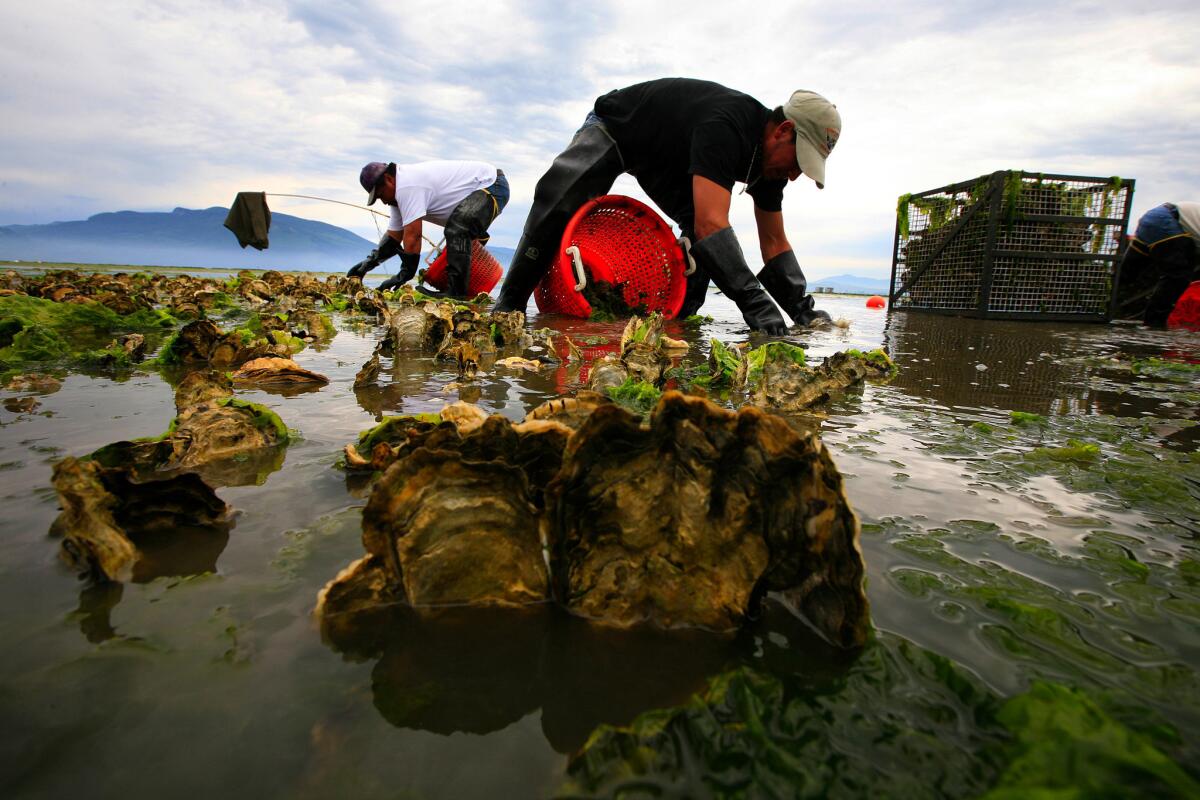Plastic microbead pollution harms oysters, the ocean’s critical ecosystem engineers, study finds

Farmers harvest oysters in Samish Bay, Wash., in 2008. A recent study found microplastic pollution harms Pacific oysters, which are grown for food on the West Coast.
Oysters eat by filtering the water around them and digesting anything small enough to trap, whether that’s algae, phytoplankton — or tiny pieces of plastic floating in the ocean.
It stands to reason that the plastic isn’t good for them. Now scientists know why: It takes such a toll on their digestive systems that their ability to reproduce is cut almost in half, according to a study published this month in Proceedings of the National Academy of Sciences.
Scientists recently estimated that the world’s oceans contain more than 5 trillion floating plastic particles, which have a combined weight of 250,000 tons.
Join the conversation on Facebook >>
Microplastic pollution “has been found on almost every beach worldwide, on polar icecaps and just about everywhere in the ocean,” said Arnaud Huvet, a marine physiologist at the French Research Institute for Exploitation of the Sea. “It’s a real concern for marine ecosystems.”
The pollutants find their way to the ocean when cosmetics, hygiene products and toothpaste containing plastic microbeads wash down the drain or when larger plastic products break down in seawater. About 4 million to 12 million tons of plastic enters the ocean each year, and that amount is expected to increase tenfold by 2025, according to a 2013 study in Science.
How does all that plastic debris impact ecosystems?
To find out, Huvet and colleagues looked to the Pacific oyster (Crassostrea gigas), a species of commercial, ecological and culinary importance around the world.
The researchers set up experimental tanks in which half the oysters received a steady diet of microalgae (their normal food) and the other half, a combination of microalgae and polystyrene microspheres.
The oysters readily gobbled up the plastic particles, which were similar in size and shape to the phytoplankton they typically eat.
These oysters ate more algae — and absorbed it more efficiently — to compensate for eating so much plastic, the study authors wrote.
But that wasn’t enough. The oysters spent so much energy dealing with the plastic in their digestive systems that they had less energy left over for reproduction.
For male oysters, that meant sperm cells were slower. For females, it meant fewer and smaller oocytes, which develop into egg cells. Compared to the oysters in the clean tanks, oysters exposed to the plastic produced 41% fewer offspring, and they were 20% smaller.
The researchers also found the plastic spheres did not stick inside the oysters’ guts, suggesting much of the material passed through their systems undigested. In the real world, oysters would also ingest larger irregularly shaped particles, which could persist in their guts for longer, potentially causing damaging inflammation, the researchers wrote.
Huvet said more research is needed on both wild and farmed oysters to really measure the impacts of microplastic pollution, but he expects strong populations of the highly fertile oysters to withstand the reduction in offspring.
Native to the east coast of Asia, Pacific oysters have traveled the world with humans looking to establish farmed populations. In some places, introduced Pacific oysters have fully taken up residence in local estuaries — so much so in Northern Europe that they’re regarded as pests, Huvet said.
However, for weaker populations of Pacific oysters — or for sparser native species such as Europe’s flat oyster, the West Coast’s Olympia and the East Coast’s eastern oyster — the decrease in quality offspring could pose a problem, Huvet said.
On the West Coast, the larger and more appetizing Pacific oysters were introduced to the waters off California, Oregon and Washington after the native Olympia oyster all but disappeared. These waters are too cold for Pacific oysters to really take off, and populations tend to be sparser and more disconnected.
As oysters live and reproduce, their shells stick together and build reefs off the shoreline. These reefs protect coastlines from floods and provide habitat for commercially important species.
But plastic pollution makes that essential work more difficult, said George Waldbusser, an ocean ecologist and biogeochemist at Oregon State University who was not involved in the study. And it adds to a growing list of stressors impacting oyster populations.
The bivalves are also threatened by ocean acidification, oxygen dead zones, rising temperatures and climate change — all of which can be traced back to humans, he said.
“I am wondering when the bivalves will decide to go on strike for better working conditions when you consider all the things we throw at them in our estuaries,” Waldbusser said. “They are essentially critical ecosystem engineers that do many positive things for humanity and our coastal waters, and yet we just continue to make it harder and harder for them to continue.”
Follow me on Twitter @seangreene89
MORE SCIENCE NEWS
If you can’t squish ‘em, join ‘em: Scientists build cockroach robot
Mercury, DDT and other contaminants in fish are at a four-decade low
Newly discovered deep-sea worms, including one named ‘churro,’ could shed light on animal evolution




